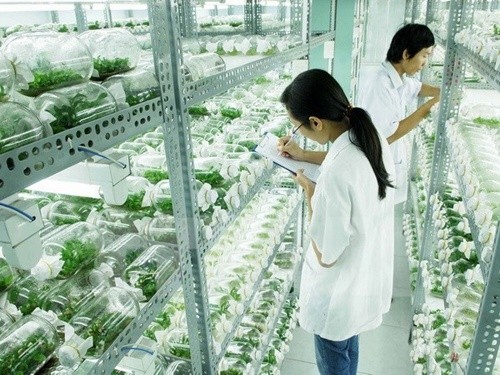(VOVworld) – A decade ago, Ho Chi Minh City set up a high-tech agriculture park to develop urban agriculture. HCMC is still leading the country in high-tech agriculture development.
 |
| “Only 1% of Vietnam’s agricultural production facilities have applied high technologies and IT. The rest continue to use traditional technologies.” (Photo: vietnamplus.vn) |
Ho Chi Minh City is Vietnam’s biggest economic hub. Each year municipal farm land loses 1,000 hectares due to urbanization.
Shrinking farm land and the fact that 1.3 million farmers are still involved in agricultural production forced municipal authorities to establish a high-tech agriculture park.
It took more than 6 years for the city to create the zone’s infrastructure and mobilize human resources.
Tu Minh Thien, deputy head of the management board of the park, says 220 people are now working there, many of them experts with MA and PhD degrees.
Thien explains further: “It is quite hard to find qualified people for the high-tech agriculture park. They must know how to use advanced technologies and equipment and adapt to new circumstances. Setting up laboratories needs to be coordinated with other activities in the park and with the staff’s expertise. We want the park to operate effectively to attract more investors.”
The 88,000-hectare park has attracted 14 high-tech agriculture businesses with a total capital of almost 16 million USD. They focus on biotechnology, cultivation without using land, production of new varieties, preservation and processing, ornamental plants, mushrooms, and medicinal plants. Advanced technologies applied to production and processing include greenhouse farming, drip irrigation systems, plant cell technology, irradiation, and postharvest heat treatment for fruits.
The park has helped farmers refine production models suitable to their localities and build brands for their strongest products.
Chau Trang, Director of the Khang Sinh Mushroom Company, a satellite business of the park, said Vietnam’s mushroom sector has a lot of potential but in past years hasn’t produced enough mushrooms to fulfill the domestic demand.
“People in HCMC are familiar with mushroom-based dishes and the market demand has been rising. Each day 1.5 tons of mushrooms are sold in HCMC. People in Tay Ninh, Binh Duong, Long An, and My Tho supply mushrooms for the HCMC market and even export to Cambodia. Our company supports farmers with improved varieties, and farming techniques, and acts as a wholesaler. Profits from growing mushrooms are much higher than from rice cultivation,” according to Trang.
The application of high-tech agriculture in HCMC has proven effective. Before 2010, Cu Chi was a poor district with a per capita income of about 860 USD a year. Thanks to investment in infrastructure and the application of science and technology to production, Cu Chi’s per capita income has almost doubled. One hectare earns 11,600 USD, nearly double the figure five years ago.
Based on the achievements so far, the HCMC authorities have targeted a land use value of 13,500 USD per hectare, half of which will go to the workers.